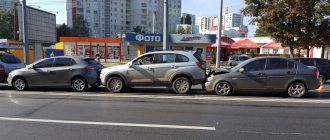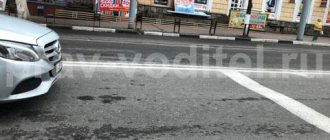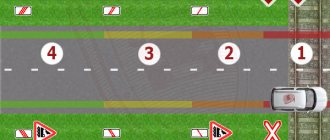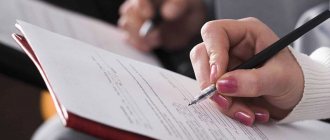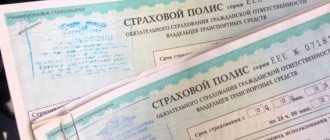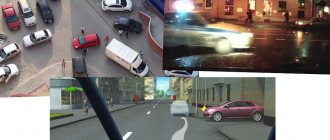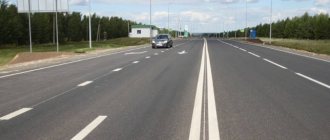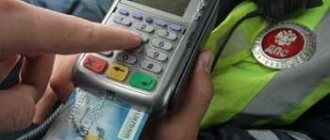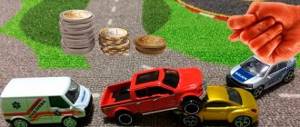Normative base
Analysis of any emergency situation, including one that occurred due to mutual fault, is carried out on the basis of the following regulations:
Attention! If you have any questions, you can chat for free with a lawyer at the bottom of the screen or call Moscow; Saint Petersburg; Free call for all of Russia.
- Provisions of the Civil Code of the Russian Federation (hereinafter referred to as the Civil Code of the Russian Federation);
- Provisions of the Code of the Russian Federation on Administrative Offenses (hereinafter referred to as the Code of Administrative Offenses of the Russian Federation);
- Requirements of the Federal Law of April 25, 2002 N 40-FZ “On compulsory insurance of civil liability of vehicle owners”;
- Articles of the Road Traffic Rules of the Russian Federation, approved by the Decree of the Government of the Russian Federation in the current edition (hereinafter referred to as the SDA);
- Departmental regulations, orders and instructions.
Definition of mutual guilt
Mutual fault in an accident is a largely controversial term and does not have a clear definition that would be enshrined in the Civil or Administrative Codes. However, as practice shows, traffic police officers and insurance companies often use this form of guilt when assessing an emergency situation. So, based on judicial practice, mutual guilt in an accident is a result of an incident in which each participant in one way or another violated traffic rules and is subject to legal liability in accordance with the Code of Administrative Offenses of the Russian Federation.
But, you need to know that, as such, a violation of traffic rules by a road user who is involved in an accident is not a direct basis for admitting mutual guilt. Thus, according to paragraph 2 of the Civil Code of the Russian Federation, compensation for damage occurs in proportion to the degree of guilt of the participants. In other words, if the violation is not related to the actual traffic accident, then the guilt is not recognized as mutual. Eg:
- The accident occurred due to the fact that one of the drivers drove through the intersection at a prohibitory signal. In this case, the second driver did not have the right to drive the vehicle. There is clearly a violation of the rules on the part of both. The first driver will be found guilty of the accident, since it was his violation that was the direct cause of the incident.
- The accident occurred because one driver entered the intersection from a secondary road and stopped to let people pass at the pedestrian crossing. However, the one who was driving along the main road significantly exceeded the speed limit and, approaching the intersection, did not have time to brake and crashed into the first one. In this case, the actions of both drivers may be classified as actions that directly led to the collision.
When is it considered mutual fault in an accident?
Mutual guilt in road traffic accidents occurs in the following cases:
- The event of an accident is a consequence of circumstances in which it is not possible to accurately determine the degree of guilt of the participants. Most often this happens in traffic areas with unregulated conditions, for example, accidents in parking lots, parking lots, etc.
- The result of an accident is a combination of circumstances in which the guilt of the participants is determined exactly, and it is their mutual actions that caused the accident.
- Cases when all parties, when registering an accident, agreed with their mutual guilt.
In any case, the guilt of one or another traffic participant or their mutual guilt is determined by the court, which may not agree with the arguments of the traffic police officers who investigated the incident or the option in which the participants themselves admitted their mutual guilt in the accident.
Statement of claim to establish the degree of fault in an accident
Filing a claim with the sole requirement to establish the degree of guilt is not provided for by law, and therefore the claim is filed for compensation for damage caused by the accident. It is within the framework of consideration of claims for damages that the degree of guilt of each participant in the accident is established.
In order for the court to accept the claim for its proceedings, it is necessary to comply with the requirements for its form and content established by the current procedural legislation, namely, indicate:
- name and address of the court
- data of road accident participants
- information from the insurance company of the second participant in the accident
- claim price
- state duty
- detailed circumstances of the accident with supporting documents attached
- available photos and videos
- data of road accident witnesses and a petition to summon them to court
- if necessary, a request for an examination
- if necessary, a request to request a photo/video
- detailed calculation of the amount of damage that is subject to compensation
- claim for damages
USEFUL : watch the VIDEO with advice from a lawyer on filing a claim in court, and also ask a question in the comments of the video to get an answer
If you seek help from a lawyer, all expenses are subject to reimbursement, and evidence of such expenses is presented to the court.
The defendants must indicate the second participant in the accident and his insurance company; the claim is filed at the place of residence/location of one of the defendants.
If the second participant in the accident has already filed a claim in court, and you believe that the accident was not your fault or that both participants were to blame for the accident, you should file a counterclaim.
When establishing mutual guilt, the court in its decision will necessarily indicate the specific amount of guilt of each participant - compensation for damage in an accident through the court will be in proportion to the established share of guilt.
Degrees of guilt
Even if a traffic accident occurred due to a violation by several traffic participants, the degree of involvement of each of them is determined. In this case, mutual fault in an accident can be:
- Equal.
This degree occurs when all road users contributed equally to the occurrence of the incident, taking into account the following mandatory conditions:
- Violation of traffic rules by each traffic participant.
- The presence of a direct connection between the violation committed by each participant and the incident event.
Consider a classic example: a car driven by a drunk driver crashes into another car driven by a sober driver. Both violated traffic rules, but the accident was caused by a sober driver. This means that the fault will not be recognized as mutual, and the drunk driver will be able to receive compensation for material damage and insurance payments. And only in the future, in accordance with Article 14 of Federal Law No. 40, the insurer, by way of a recourse claim, will demand compensation for the amount of insurance payments from the drunk driver.
- Equal severity of traffic violations committed. In order to determine equal severity, the number of violations of the provisions of the Traffic Rules and the severity of the punishment for them, which is provided for in the Code of Administrative Offences, are taken into account. If they are approximately equal, then the judge makes a decision on equal mutual guilt in the accident if the first two points are present.
- Various.
This degree is determined in cases where one of the participants violated the rules like the second, and both violations caused the accident, but the actions of the first were less gross than the second. When making a decision, the judge relies on the same conditions as when determining equal guilt. The fact is that there is simply no other method, and in some cases, even a highly professional expert will not be able to determine the degree of guilt of a particular driver in an accident.
A striking example of an accident with varying degrees of fault is the case when the driver of a faulty car, stopping on the side of the road, did not put up a warning sign and did not turn on the hazard warning lights. Another driver, moving in the same direction, significantly exceeding the set speed, without noticing a broken down car on the road, drives into it. Wherein:
- Both drivers violated the traffic rules that caused the accident: one did not set the required stop sign and did not turn on the hazard lights, and the second exceeded the speed limit, did not make sure that nothing was obstructing him and failed to avoid the accident.
- The violations of the first driver are less serious. After all, if the other participant in the accident had not exceeded the speed limit, then most likely he would have been able to avoid the collision.
Thus, any court will decide on various mutual faults in an accident.
Procedure for registering an accident
Step-by-step instructions for filing a mutual accident:
- Turn off the engine, put the car on the parking brake, turn on the warning lights and put up a warning triangle.
At night, on the roadway or side of the road, you must wear a jacket or cape vest with elements of reflective material that meet the requirements of GOST 12.4.281-2014. (Traffic rules clause 2.3.4)
- Call the traffic police, you can do this via the hotline.
- Try to find witnesses to the incident on your own, record the damage and the location of the cars with a camera, and if possible, ask other participants about the movement of video recordings.
- Upon arrival of the traffic police officers, tell them as fully as possible about the event and make sure that your words are accurately recorded in the protocol.
- Based on the circumstances of the accident, insist on your innocence.
If there is confidence that the collision was provoked by another participant, then you will have to go to court, where you will need to defend your position.
In case of minor damage to cars and no injuries, it will be possible to draw up a “Euro protocol” without calling the traffic police.
In cases where the traffic police inspector is involved in documenting the result of an accident, it is necessary to unobtrusively monitor his work, especially pay attention to the preparation of the following documents:
- Certificate of traffic accident for each participant.
- A protocol that should reflect:
- car layout;
- distances from reference points;
- description of damage;
- explanations from drivers and eyewitnesses.
- A resolution on the offense indicating a specific article of the Code of Administrative Offenses of the Russian Federation.
Registration of the incident
If all participants in the accident admit their guilt and do not make claims against the others, you can get by with the Europrotocol. But it is important to remember that the maximum payment amount for such registration is 100 thousand rubles. This means that each driver can receive 50 thousand from the insurer. If the amount of damage is significant, it is worth spending time and waiting for the traffic police.
In the latter case, documents will be prepared that need to be provided to the insurer or the court. This:
- certificate of accident - both drivers receive one copy;
- protocol;
- resolution on the offense - one copy for each driver (based on them, guilt will be distributed).
The protocol is also used to determine the degree of guilt of each car owner, as it states:
- location of cars after an accident (also in the form of a diagram);
- measurement indicators;
- damage that can be determined visually;
- statements from each driver.
Note! Even if the participants in the accident have no claims against each other and admit mutual guilt, it is better to file an accident with traffic police officers, because it is not always possible to determine the amount of damage “by eye.”
Damage compensation procedure
To an uninitiated person, it may seem that if an accident occurs due to mutual fault, then the participants in the accident do not pay each other anything, and guilt and repair costs seem to be balanced. However, this is a fundamentally wrong opinion. Paragraph 22 of Article 12 of the Federal Law “On Compulsory Insurance of Civil Liability of Vehicle Owners” states that insurance companies must pay money for damage caused in strict accordance with the degree of guilt of each participant in a traffic accident as determined by the judicial authorities.
If the degree of guilt cannot be determined even in court, then the insurance companies that insure the liability of drivers compensate for property damage in the event of an accident in equal amounts.
Similar requirements are contained in the Civil Code of the Russian Federation, and more specifically in Article 1083, which states that the amount of compensation is reduced in the presence of gross negligence of the victim, which provoked the incident.
Thus, payment of damages in case of an accident with mutual fault is made in the usual manner without providing additional documents and evidence. When assigning payments, the following circumstances are taken into account:
- in order to correctly calculate payments, the degree of culpability of the participants in the accident is taken into account;
- the basis for making payments is a court decision;
- if the judge was unable to determine the degree of guilt of the participants in the incident, then payments are made in equal shares.
Payments under compulsory motor liability insurance in case of mutual fault
In accordance with Article 12 of the so-called law “On Compulsory Motor Liability Insurance”, payments to victims in a road accident are made in proportion to the degree of guilt. And the degree of guilt is calculated in two values:
- Equal.
The most common variant of mutual fault in an accident. It is established either in court or in cases where the investigation of the incident did not reach the court. In such cases, each participant in the accident receives a payment equal to 50% of the damage caused to him.
An example of calculating equal payments is the following case: two cars were damaged in a traffic accident. Repairing the first one will cost 60 thousand rubles, repairing the second one will cost 30 thousand rubles. The court, having considered the circumstances of the accident, recognized the equal mutual guilt of both participants. In this case, the owner of the first car can count on payments in the amount of 30 thousand rubles, the owner of the second – 15 thousand rubles. You will have to find the missing funds yourself.
But there are cases when the damage caused to the car is so great that even the amount that the insurance company will pay to the owner exceeds the amount of insurance payments under normal circumstances. Here you can go to court and demand the necessary money from the participant in the accident. However, this can only be done in the amount of 50% of the total amount.
- Proportional to the guilt.
In cases where the court has determined that all participants are to blame for a road collision, only to varying degrees, then payments of insurance amounts will be proportional to the degree of guilt.
If we consider the previous example and accept that the court determined that the first driver was 10% at fault, and the second 90% at fault, then payments will be made in the following amounts:
- the first driver will receive 54 thousand rubles;
- the second - 3 thousand rubles.
Payment under CASCO in case of mutual fault
The specifics of payments to drivers under CASCO insurance are determined by the specific provisions of the insurance contract. If a road traffic accident with mutual fault falls under the terms of insurance and there are no reasons for denial, then the entire insured amount will be paid in full. The insurance company is not interested in whether the victim is at fault.
The grounds for refusal to pay funds must be clearly stated in the contract. If the insurer fails to comply with its obligations, the driver has the right to seek help from the court.
When and how to prove mutual guilt in court
To be successful in court, several recommendations should be taken into account:
- It is necessary to prove mutual guilt if the party does not agree with the position of the opponent or with the conclusion of the insurer.
- To prove the crime, you can use materials from the traffic police, as well as witness testimony and personally collected arguments (photos, videos, etc.).
- Give other circumstances of the case, for example, weather conditions. If it was a rainy day, you can refer to the condition of the road surface (you will have to provide a certificate from the hydrometeorological center).
- It is advisable to provide the court with expert reports - on the technical condition of the car, the extent of damage, etc.
It is important to consider here that the court makes a decision based on the totality of the circumstances. Therefore, as the process progresses, the parties decide what evidence is worth bringing and what is not.
Mutual fault in an accident with victims
If in a traffic accident that occurred due to mutual fault there are injuries or even deaths, then, depending on the severity of the harm to health, the drivers responsible for the incident will face administrative or criminal liability.
In accordance with the provisions of the Plenum of the Supreme Court of the Russian Federation No. 25 of June 23, 2015, administrative or criminal liability, including imprisonment, will be borne by both participants in the road accident.
- For harm caused to oneself, you will not have to bear punishment, but the other culprit of the accident will be held accountable depending on the degree of guilt.
- Both drivers responsible for the accident will be responsible for harm caused to an unauthorized participant or passenger in a mutual accident.
Appeal against mutual guilt
For a driver who is found guilty of an accident, adverse consequences occur, expressed in compensation for material damage and execution of punishment. Sometimes, when an accident is recognized as a mutual accident, situations arise when one of the participants considers himself to be unreasonably accused. The optimal way to restore legality for such a driver is to challenge the guilt.
It is worth noting that a participant in a traffic accident is found guilty in the case where there is a stable cause-and-effect relationship between the traffic violation and the accident.
The procedure for appealing against mutual fault in an accident is relevant in the following cases:
- Disagreement of the participant in the accident with the act, which contains conclusions regarding the violation of the rules.
- Lack of a clear cause-and-effect relationship between traffic violations and road accidents.
- Violation of procedural rules and requirements by the person who makes a decision in the case.
The appeal itself can take place in the following order:
- Pre-trial - through a complaint to higher authorities of the traffic police.
- Through the court.
- In civil proceedings.
An appeal against guilt can occur with the aim of assigning mutual guilt in an accident.
What does a double accident mean?
There is no official document that would spell out the concept of mutual fault in a road accident. Logically, a mutual road accident is a situation where in the incident there is one or another degree of fault of both (or several) drivers. A paradoxical situation arises: each of the motorists is simultaneously both the guilty and the victim.
Double guilt is recognized in the following cases:
- it is not possible to determine the guilt of a particular party for any reason;
- when analyzing the circumstances of a road incident, the fault of each driver is clearly visible;
- Both parties to the accident, when drawing up a European protocol, acknowledge mutual guilt in writing.
Examples of judicial practice
Judicial practice is replete with cases in which road traffic accidents that occurred due to mutual fault are considered.
- In April 2021, the Volzhsky District Court of Samara issued a conclusion in the case of compensation for damage after an accident due to mutual fault. One driver of the vehicle violated the rules for driving through intersections, and the second exceeded the speed limit. The driver who exceeded the speed did not agree with mutual guilt, in which responsibility is imposed in equal shares, and demanded that the blame be distributed in proportions of 10 to 90%. The driver who violated the rules for driving through the intersection, based on expert opinions, was able to prove in court that if the second driver had not exceeded the speed limit, he would have been able to avoid the accident. As a result, the court left the decision on mutual guilt in equal shares unchanged.
- In July 2021, the Sovetsky District Court of Tula issued an opinion on the following case. The accident that occurred in early 2017 involved a driver who failed to give way to a vehicle moving on the main road. The fact that indicated that the car on the main road was moving at a significant speed limit was not taken into account by the traffic police officers. After all the insurance settlements had been made, the victim filed a lawsuit to recover from the culprit the funds needed to repair the car. However, in court, the culprit of the accident presented data that indicated that the victims were speeding, after which the court decided to recognize the accident as a mutual fault and reduce the amount of recovery by half.
If the insurance company refuses compensation
As in any other insurance case, the insurance company may refuse to pay compensation under the policy. The possibility of challenging depends on the legality of the company's actions.
Thus, the insurer’s refusal will be legal if:
- deadlines for notification of an insured event were violated;
- an incomplete list of documents is provided;
- unauthorized leaving the scene of the incident before the arrival of traffic police officers was recorded;
- the car owner was intoxicated;
- the absence of an insurance policy or the absence of the person driving the car from the list of those allowed to drive the car was recorded.
If the insurance company refuses payment on legal grounds, you need to eliminate the reason and file a claim again. For example, supplement the package of documents or provide valid reasons why deadlines were violated or the scene of the incident was left behind. In the latter case, it is necessary to provide evidence (for example, a certificate from the hospital where the driver was in a hurry).
If you can't get the money, you need to:
- submit to the insurance pre-trial claim;
- go to court.
Some nuances
- Registration of the European protocol.
The question often arises: is it possible to issue a European protocol if both participants in the accident are at fault? In accordance with Article 12 of the Law “On Compulsory Motor Liability Insurance” and the provisions of the Plenum of the Supreme Court of the Russian Federation No. 25 of June 23, 2015, payments for mutual fault are made in equal shares, unless the court establishes a proportional ratio of fault. In addition, no documents from the traffic police are required to make insurance payments.
Thus, if an accident occurs, you can use the European protocol, but only in cases where both participants admit their own guilt and there are no disputes between them.
- Is it possible to leave the scene of an accident if it is both at fault?
In accordance with the traffic rules of the Russian Federation, it is possible to leave the scene of a traffic accident in cases where a European protocol has been drawn up or when a diagram of the accident has been drawn up and both drivers have gone to the nearest traffic police station for further registration.
In all other cases, leaving the scene of an accident without good reason entails administrative liability, up to and including deprivation of the right to drive a vehicle, regardless of the degree of guilt.
Let's sum it up
When an accident occurred due to violations committed by both participants in the incident, we are talking about mutual guilt. Such accidents have their own characteristics:
- guilt is recognized as mutual if both drivers violated the rules and an appropriate protocol has been drawn up against each of them;
- We are also talking about a “mutual relationship” if the guilt of each participant cannot be established;
- in such accidents, the insurance company recognizes the same degree of guilt of each driver if they do not go to court;
- during court proceedings, the guilt may be equal or different, based on this, the amount of payments is assigned;
- in case of mutual guilt, a European protocol can be drawn up (if the participants do not disagree and the damage is small) or a protocol can be drawn up with a call to the traffic police;
- if you disagree with the determination of the degree of guilt, you need to go to court and prove your position, citing as much evidence as possible;
- if the insurer refuses to pay, you should send a pre-trial claim to the company, then go to court if the issue cannot be resolved amicably.
Thus, in a situation where both drivers are to blame for the accident, the insurer also pays. But it is important to follow the procedure and requirements for registering an accident and contacting the Investigative Committee.
